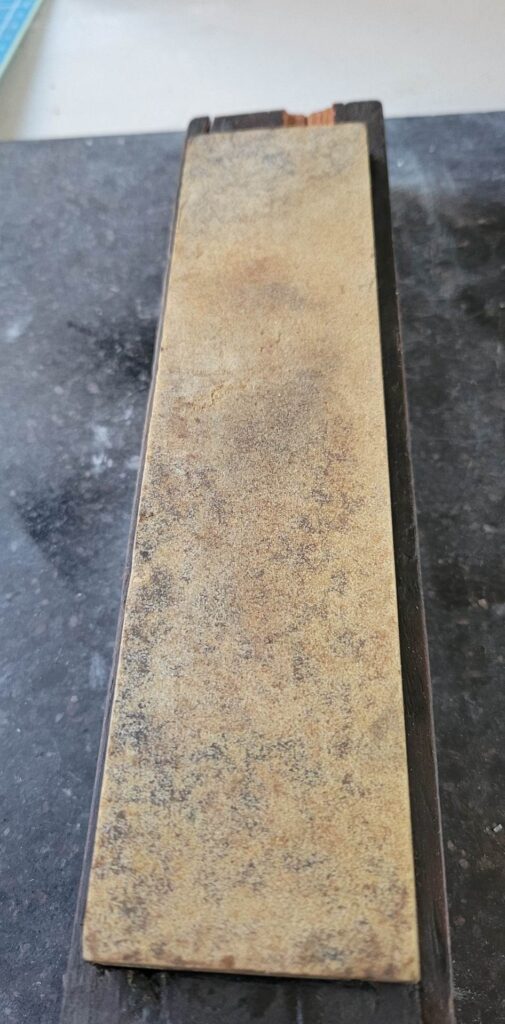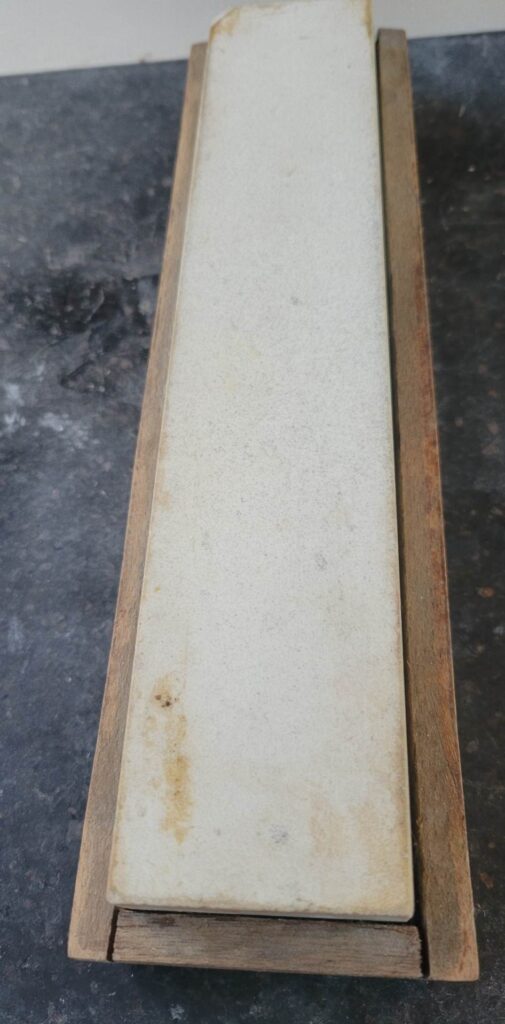Washita Oilstones are a novaculite whetstone from the Ouchita Mountains by Hot Springs Arkansas known for its porous structure and fast cutting performance. What we call Novaculite, including the Washita Oilstones and Arkansas Whetstones as well as others from around the world have been used for thousands of years in the use of some of the earliest tools of mankind. These stone beds were used to create some of the earliest tools from daggers to arrow heads. The site where the easily accessible stone beds were pulled from was located three miles from the Hotsprings of Washita and were between 250 to 900 feet thick.
The Washita and Arkansas stones are drawn from the same area but perform differently. The Washita stones have a more porous structure to them (meaning their matrix has pockets or holes throughout it) and is less dense than the Arkansas variety of Novaculite.
Sections
History
Use
No 2. Washita
No 1. Washita
Lily White Washita
Rosy Red Washita
Washita Oilstone History
Washita Oilstones get their name from the surrounding area’s Ouchita Mountains and Ouchita River. Washita is an English phonetic version of this Native American Ouchita word. Washita and Arkansas stones are two of the most popular novaculite stones in the world and had a massive impact on the pre-synthetic whetstone industry.
The phrase Novaculite was coined in 1794 by an Irishman called Richard Kirwan in his book Elements of Mineralogy. He took it from the Latin ‘novacula’ meaning ‘razor stone’, to refer to a particular type of British chert that was very good for making whetstones. This original stone was very likely the whetstone we now know of as ‘Llyn Idwal’.
The name did not catch on though in the scientific work and is mostly relegated to those dealing in whetstones. More properly, the stone is a type of Sedimentary Quartz (a term which Schoolcraft attempted to get coined as well but failed) formed into a microcrystalline matrix. Novcaulite in a geological sense would probably fall under the moniker of Chert, Flint, or rarely Quartzite. Washita novaculite is extremely pure in its composition, being at or above 99.5 percent silica.
In 1818 the first real reports of this stone beginning its proliferation were recorded and it was discussed that it was an equal to the Turkish Oilstone – at the time renowned as top of its class.
In the 1890s there were only two companies processing Washita stones, the New York factories of Pike Manufacturing and George Chase.
The Washita stone was a significantly cheaper stone to procure at the time, as about 50% of all stone pulled from the ground could be utilized to make whetstones or in other industrial applications while the Arkansas variety had only about 25% usable rock material in comparison. Additionally, the more porous nature of the Washita stone lent itself to shaping on saws better with less fracturing – thus more of the material was successfully harvested. Both of these elements played into the Washita being far cheaper to buy than Arkansas stones at any time.
While the Arkansas stone was still successful in the pre-synthetic stone market, the Washita was significantly so. Many stones such as local slate could perform a similar role to the expensive Arkansas stone, but few local areas have quality fast-cutting low wearing stones like the Washita Oilstones. As such, around the world many regional whetstones were immediately replaced by craftsmen in the woodworking trades upon the Washitas immediate availability in their market.
Washita oilstones are no longer in production. The last notable runs were from Hiram A. Smith in the 1960s, as well as Norton Abrasives launched limited runs in 1980 and 2000s of the Lily White variety. Dan’s Whetstones has in the past produced a “Washita” stone which is actually a high quality Soft Arkansas. It is possible for Norton to do additional runs of the stone as they still own the mines in Arkansas to produce Washita Oilstones, but they have maintained it is no longer economically viable to produce.
Washita Oilstone Use
Similar to the Arkansas stone, Washita Oilstones can be used with either water or oil. Unlike the Arkansas stone though, the Washita performs significantly worse when used only with water. In such use, the stone is often scratchy to metal and cuts slowly as its porous structure is quickly filled with swarf (microscopic metal shavings). The use of oil with the stone ensures its abrasive particles are less scratchy by lubricating their surface better than water. As well, the oil suspends the swarf particles as water is unable to – allowing the pores of the stone to stay open and the cutting performance to remain.
One benefit to Washita Oilstones is their relatively hard matrix structure. Unlike many other comparable whetstones such as the Hindostan, this structure dishes very slowly as it is used. In fact, you will see almost no slurry or sediment from the stone kick up as you are using it due to the hardness of the stone. This means that the stones stay flat longer and is used up much slower than other comparable stones.
This unique porous crystalline structure also responds particularly well to pressure. With a light pressure, Washita Oilstones may cut at a similar rate or even slower than other comparable stones from Japan, UK, or the US. However, the Washita Oilstone drastically increases its cutting performance with the pressure in a way the other stones do not. Because the surface is very tough, slick, and does not give under pressure this allows you to grind the metal much faster for applications that can endure high levels of pressure. In particular, this quality makes Washita Oilstones well suited for edge tools such as chisels and plane blades.
Washita Oilstones can be very useful knife or other utility stones due to their cutting speed and durability. If used for razor honing, even the Hard/Fine labelled Washitas will generally only get you to bevel setting or the pre-finished stage of the razor process. In this case, the porous nature of the stone does not deliver a fine enough performance to get a razor to a satisfactory edge. As with all natural stone, there is very likely a small amount of Washita which is in-fact fine enough to finish razors – but they are the exception to the rule.
For stones that are not marked as coarse/soft or hard/fine, you can often tell how coarse the stone will be by hose large the pores appear when looking at the stone. Additionally, a soft variety can be easily marred with a knife where as a hard variety will not be scratched easily. Lastly, you can tap the stone with a knife and listen to the noise it makes. If the sound is returned as similar to a block of wood it will be a softer stone, if it clinks with a sharper ring it is more likely to be a hard stone.
No 2 Washita Oilstones
An ungraded form of Washita which promised at least one good cutting face. The grading did not guarantee any specific level of performance so it could range from softer to finer. Washita Oilstones which were labeled and sold as No. 2 varieties were less likely to be a single homogonous block that lacked larger than normal holes, cracks, or inclusions. Due to this imperfect structure, they were sold cheaper and labelled as such.
Analogous Slurry Grit: 600-800
Analogous “Upper End Conditioned” Grit Rating: 5000
Specific Gravity: 2.25 or less.
No 1 Washita Oilstones
The second ungraded form of Washita sold and promised to be free from any significant cracks, inclusions, or strange composition. These stones were by far the most common variety sold during the Washita Oilstones height. Calico colored versions of the No. 1 Washita Oilstones are very sought after as they often have fantastic cutting capabilities.
Analogous Slurry Grit: 600-800
Analogous “Upper End Conditioned” Grit Rating: 5000
Specific Gravity: 2.25 or less.
Lily White Washita Oilstones
Considered the best of the Washita as it was actually graded and guaranteed to perform at a certain level. Lily Whites often perform like a very high-quality Soft Arkansas, so will be often referred to within the same analogous range but will perform more often at the top end of said range. This stone in particular is sought after for its beautiful color, good quality, and value as a collector’s item due to its increasing rareness in the market.
For a period of time Pike sold these with additional grading labels of Soft/Coarse and Hard/Fine. It was recommended to use the Soft/Coarse stones for carpenter’s tools such as plane irons, chisels etc. Alternatively, the Hard/Fine variety was recommended for narrow tools and pointed instruments that would otherwise wear grooves into softer stones.
Analogous Slurry Grit: 600-800
Analogous Slurry Grit: 600-800
Analogous “Upper End Conditioned” Grit Rating – Soft Variety: 5000
Analogous “Upper End Conditioned” Grit Rating – Fine Variety: 6000-7000
Specific Gravity: 2.25-2.30
Rosy Red Washita
Functionally a version of the Lily White Washita which had a red tinge to them. They were considered to be the same quality as the Soft/Coarse version of the Lily White and were treated as such when being sold. These are very rare in modern times, thus being highly sought after and exceptionally valuable.

